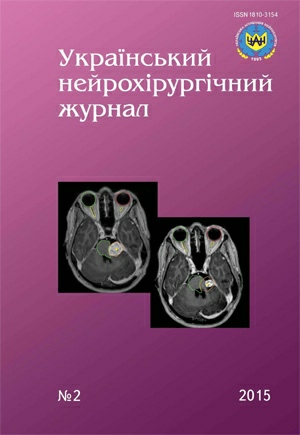Skull and brain gunshot wound during the armed conflict in eastern Ukraine. Report 2. Surgical treatment
DOI:
https://doi.org/10.25305/unj.45295Keywords:
penetrating craniocerebral wounds, mine-explosive wounds, bullet wounds, surgical treatment, mortality, postoperative complicationsAbstract
Purpose. To improve the results of surgical treatment in patients with penetrating craniocerebral wounds (PCCW) by implementing optimal treatment strategy considering type of the injury, character of intra- and extracranial injuries.
Materials and methods. The results of examination and treatment of 41 injured persons with PCCW wounded in local fighting in the East of Ukraine. The injured persons were hospitalized to I. Mechnikov Dnipropetrovsk Regional Clinical Hospital in f period from May 25 to December 31 2014. In 37 (90.2%) patients PCCW were caused by mines and explosive devices, in 4 (9.8%) — by bullets. Rebound injuries were diagnosed in 15 (36.6%) patients, blind — in 20 (48.8%), perforating — in 6 (14.6%).
Results. Three main tasks of the surgical treatment of patients with PCCW were identified: hemostasis, infection prevention, prevention and correction of intracranial hypertension. To perform the tasks we justified the full implementation of 12 critical steps of the surgery. The introduction of more aggressive treatment principles reduced mortality to 7.3%. Postoperative complications occurred in 24.4% cases, most frequently liquorrhea (in 12.2%) and purulent-septic complications (in 12.2%) were diagnosed, rarely — vascular complications, and hydrocephalus.
Conclusions. The primary goal of PCCW surgical treatment — is surgery performing in full during one surgical intervention. At penetrating wounds debridement all nonviable tissue should be removed radically: detritus, blood clots, areas of brain crush, foreign bodies. At primary debridement primary skin reconstruction, dura mater of the brain, skull base and calvaria, and inflow-outflow wound drainage should be widely used.
References
Nevidkladna viyskova khirurhiya. Lviv: Nautilus, 2015. Ukrainian.
The Joint Trauma System Clinical Practice Guidelines [Internet]. United States Army Institute of Surgical Research; 2014. [cited 2014 December 16]. Available at: URL
Polishchuk NE, Starcha VI. Ognestrelnyye raneniya golovy. Kiev: TOV ToN, 1996. Russian.
Pedachenko EG, Danchyn OG, Polishchuk ME, Tsymbalyuk VI. Orhanizatsiya nadannya spetsializovanoyi neyrokhirurhichnoyi dopomohy u viyskovyy chas (z·hidno oboronnoyi viyskovoyi doktryny). Metodychni vkazivky. Kiev, 2014. Ukrainian.
Konovalov AN, Likhterman LB, Potapov AA, ed. Cherepno-mozgovaya travma. Klinicheskoye rukovodstvo. Moscow: ANTIDOR, 2001. Russian.
Gaydar BV., editor. Prakticheskaya neyrokhirurgiya. Rukovodstvo dlya vrachey. St. Petersburg: Gippokrat, 2002. Russian.
Knuth T, Letarte PB, Ling G, Moores LE, Rhee P. Guidelines for field management of combat-related head trauma. New York: Brain Trauma Foundation, 2005. [cited 2014 December 16]. Available at: URL
Klinichni protokoly nadannya medychnoyi dopomohy za spetsialnistyu neyrokhirurhiya [Neurosurgery protocols]. Ukrainian Neurosurgical Journal. 2008;(3):144-151. Ukrainian. [eLIBRARY]
Mogila VV, Siomkin KV. [Surgical extraction peculiarities of the foreign bodies in weapon wounds of the head in the peace time]. Ukrainian Neurosurgical Journal. 2005;(3):97-100. Russian. [eLIBRARY]
Mogila VV, Syomkin KV. [Gunshot wounds to the head in the peace time]. Ukrainian Neurosurgical Journal. 2003;(2):50-53. Russian. [eLIBRARY]
Samotokin BA. Boyevyye raneniya i porazheniya cherepa i golovnogo mozga. In: Arutyunov AI., editor. Rukovodstvo po neyrotravmatologii. Moscow: Meditsina; 1979. V2, p.313-359. Russian.
Zavadskiy NA. Otdalennyye posledstviya i oslozhneniya pronikayushchikh raneniy cherepa i mozga. Kirov, 1956. Russian.
Hammon W. Analysis of 2187 consecutive penetrating wounds of the brain from Vietnam. Journal of Neurosurgery. 1971;34(2part1):127-131. CrossRef
Hammon W. Retained intracranial bone fragments: analysis of 42 patients. Journal of Neurosurgery. 1971;34(2part1):142-144. CrossRef
Pitlyk P, Tolchin S, Stewart W. The experimental significance of retained intracranial bone fragments. Journal of Neurosurgery. 1970;33(1):19-24. CrossRef
Pykhonin SN. Preduprezhdeniye i lecheniye ognestrelnykh raneniy cherepa i golovnogo mozga [dissertation]. Leningrad (Russia): Kirov Military Medical Academy; 1992. Russian.
Gaydar BV, Shulev YuA, Verkhovskiy AI, Parfenov VE. Boyevyye povrezhdeniya tsentralnoy nervnoy sistemy. Klinicheskaya meditsina i patofiziologiya. 1998;1:55-65. Russian.
Popov VS. Infektsionnyye oslozhneniya ognestrelnykh ran cherepa i ikh lecheniye. In: Experience of Soviet Medicine in Afghanistan: Proceedings of the All-Army Research Conference; 26-27 October 1992; Moscow, Russia. p. 42-43. Russian.
Teplyashin VF, Pykhonin SN, Zagorodniy FF, Suri GM. Prilivno-otlivnoye drenirovaniye cherepno-mozgovykh ran v sisteme profilaktiki posleoperatsionnykh oslozhneniy. In: Actual Issues of Military Medicine: Proceedings of the Scientific conference devoted to the 10th anniversary of the April Revolution; 1988; Kabul, Afghanistan. p. 139-140. Russian.
Downloads
Published
How to Cite
Issue
Section
License
Copyright (c) 2015 Andriy Sirko

This work is licensed under a Creative Commons Attribution 4.0 International License.
Ukrainian Neurosurgical Journal abides by the CREATIVE COMMONS copyright rights and permissions for open access journals.
Authors, who are published in this Journal, agree to the following conditions:
1. The authors reserve the right to authorship of the work and pass the first publication right of this work to the Journal under the terms of Creative Commons Attribution License, which allows others to freely distribute the published research with the obligatory reference to the authors of the original work and the first publication of the work in this Journal.
2. The authors have the right to conclude separate supplement agreements that relate to non-exclusive work distribution in the form of which it has been published by the Journal (for example, to upload the work to the online storage of the Journal or publish it as part of a monograph), provided that the reference to the first publication of the work in this Journal is included.









